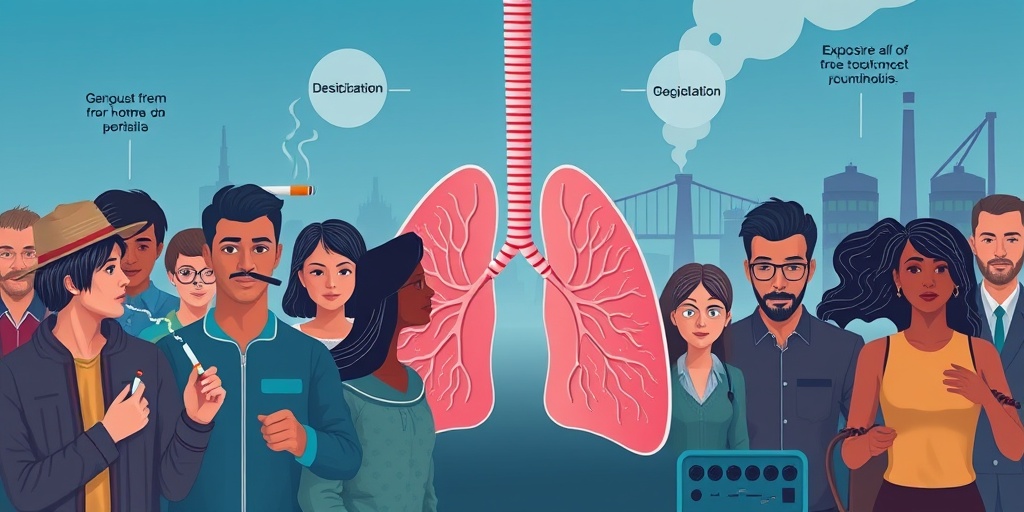What Is Giant Cell Interstitial Pneumonia?
Giant Cell Interstitial Pneumonia (GCIP) is a rare and complex lung condition characterized by inflammation and damage to the lung tissue. It falls under the broader category of interstitial lung diseases, which affect the interstitium—the tissue and space around the air sacs (alveoli) in the lungs. This condition is particularly notable for the presence of giant cells, which are large cells that can form when the immune system responds to injury or infection.
Understanding the Pathology
The pathology of Giant Cell Interstitial Pneumonia involves a combination of inflammatory processes and fibrotic changes. The giant cells are typically formed from the fusion of macrophages, a type of immune cell, in response to chronic inflammation. This can lead to scarring of the lung tissue, which impairs the lungs’ ability to function properly.
GCIP is often associated with other conditions, such as giant cell arteritis, which can complicate the clinical picture. The exact cause of GCIP is not always clear, but it may be linked to autoimmune diseases, infections, or exposure to certain environmental factors.
Radiological Features
Radiology plays a crucial role in diagnosing Giant Cell Interstitial Pneumonia. Imaging studies, particularly high-resolution computed tomography (HRCT) scans, can reveal characteristic patterns of lung involvement. Common findings include:
- Ground-glass opacities: These appear as hazy areas on the scan, indicating inflammation.
- Reticular patterns: These are indicative of fibrosis and scarring in the lung tissue.
- Nodules: The presence of nodules can suggest the formation of granulomas, which are clusters of immune cells.
These radiological features are essential for differentiating GCIP from other interstitial lung diseases, ensuring accurate diagnosis and treatment.
Giant Cell Symptoms
The symptoms of Giant Cell Interstitial Pneumonia can vary widely among individuals, often depending on the severity of the disease and the extent of lung involvement. Common symptoms include:
Respiratory Symptoms
- Chronic cough: A persistent cough that may be dry or produce sputum.
- Shortness of breath: Difficulty breathing, especially during physical activity.
- Chest pain: Discomfort or pain in the chest area, which may worsen with deep breaths.
Systemic Symptoms
- Fatigue: A general feeling of tiredness or lack of energy.
- Weight loss: Unintentional weight loss can occur due to chronic illness.
- Fever: Low-grade fever may be present, indicating an inflammatory process.
It’s important to note that these symptoms can overlap with other respiratory conditions, making it essential for individuals experiencing them to seek medical evaluation. Early diagnosis and intervention can significantly improve outcomes for those with Giant Cell Interstitial Pneumonia.
When to Seek Medical Attention
If you or someone you know is experiencing persistent respiratory symptoms, it is crucial to consult a healthcare professional. Early detection and treatment can help manage the condition effectively. Resources like Yesil Health AI can provide valuable, evidence-based health answers to help guide your understanding and next steps.
In conclusion, Giant Cell Interstitial Pneumonia is a serious lung condition that requires careful diagnosis and management. Understanding its pathology and symptoms can empower patients and their families to seek timely medical care and improve their quality of life. 🌬️💙

Giant Cell Causes
Giant Cell Interstitial Pneumonia (GCIP) is a rare and complex lung condition characterized by inflammation and damage to the lung tissue. Understanding the causes of this disease is crucial for effective diagnosis and treatment. Let’s delve into the primary causes associated with GCIP.
1. Autoimmune Disorders
One of the significant causes of Giant Cell Interstitial Pneumonia is autoimmune disorders. Conditions such as rheumatoid arthritis and systemic lupus erythematosus can trigger an abnormal immune response, leading to inflammation in the lungs. In these cases, the body mistakenly attacks its own tissues, resulting in the formation of giant cells in the interstitial spaces of the lungs.
2. Infections
Infections can also play a role in the development of GCIP. Certain viral and bacterial infections may lead to interstitial pneumonia, causing the immune system to react aggressively. For instance, viral infections like influenza or bacterial infections such as those caused by Mycoplasma pneumoniae can contribute to the onset of this condition.
3. Environmental Exposures
Exposure to certain environmental factors can increase the risk of developing Giant Cell Interstitial Pneumonia. This includes:
- Occupational hazards: Workers in industries such as construction, mining, or agriculture may be exposed to harmful substances that can irritate the lungs.
- Air pollution: Long-term exposure to polluted air can lead to chronic lung conditions, including GCIP.
- Smoking: Tobacco smoke is a well-known irritant that can exacerbate lung inflammation and contribute to the development of interstitial pneumonia.
4. Genetic Factors
While the exact genetic factors contributing to Giant Cell Interstitial Pneumonia are still being researched, there is evidence to suggest that a family history of lung diseases may increase susceptibility. Genetic predispositions can influence how the body responds to environmental triggers and infections, potentially leading to the development of GCIP.
Giant Cell Risk Factors
Identifying the risk factors associated with Giant Cell Interstitial Pneumonia is essential for early detection and prevention. Here are some of the key risk factors to consider:
1. Age
Age is a significant risk factor for GCIP. This condition is more commonly diagnosed in adults, particularly those over the age of 50. As we age, our immune system may become less effective, making it easier for inflammatory processes to take hold in the lungs.
2. Gender
Research indicates that Giant Cell Interstitial Pneumonia may be more prevalent in males than females. While the reasons for this disparity are not entirely understood, hormonal differences and lifestyle factors may play a role.
3. Pre-existing Lung Conditions
Individuals with a history of lung diseases, such as chronic obstructive pulmonary disease (COPD) or asthma, are at a higher risk of developing GCIP. These conditions can compromise lung function and increase susceptibility to further lung damage.
4. Smoking History
As mentioned earlier, smoking is a significant risk factor for many lung diseases, including Giant Cell Interstitial Pneumonia. Smokers are more likely to experience chronic inflammation in the lungs, which can lead to the development of interstitial pneumonia.
5. Occupational Exposures
Certain occupations expose individuals to harmful substances that can increase the risk of lung diseases. Jobs that involve exposure to asbestos, silica dust, or other respiratory irritants can contribute to the development of GCIP. It’s essential for individuals in high-risk occupations to take preventive measures to protect their lung health.
In conclusion, understanding the causes and risk factors associated with Giant Cell Interstitial Pneumonia is vital for early diagnosis and effective management. If you or someone you know is experiencing respiratory symptoms, it’s important to consult a healthcare professional for a thorough evaluation. 🌬️💙

Giant Cell Diagnosis
Diagnosing Giant Cell Interstitial Pneumonia (GCIP) can be a complex process, as it often mimics other lung diseases. This condition is characterized by the presence of giant cells in the lung tissue, which can lead to significant respiratory issues. Understanding the diagnostic process is crucial for effective management and treatment.
Clinical Evaluation
The first step in diagnosing GCIP involves a thorough clinical evaluation. Physicians will typically start with a detailed medical history and a physical examination. Key symptoms to look out for include:
- Persistent cough: A dry or productive cough that doesn’t seem to improve.
- Shortness of breath: Difficulty breathing, especially during physical activity.
- Fatigue: Unexplained tiredness that affects daily activities.
- Chest pain: Discomfort or pain in the chest area.
Imaging Studies
Once the initial evaluation is complete, imaging studies are often the next step. Chest X-rays and CT scans are commonly used to visualize the lungs and identify any abnormalities. In cases of GCIP, imaging may reveal:
- Ground-glass opacities: Areas of increased opacity that indicate inflammation.
- Nodules or masses: Potential signs of lung lesions.
- Reticular patterns: Indicative of interstitial lung disease.
Histological Examination
The definitive diagnosis of GCIP often requires a biopsy of lung tissue. This can be obtained through various methods, including:
- Bronchoscopy: A minimally invasive procedure that allows doctors to collect tissue samples from the lungs.
- Video-assisted thoracoscopic surgery (VATS): A more invasive approach that provides a larger sample for analysis.
Histological examination will reveal the presence of giant cells, which are a hallmark of this condition. Pathologists will also look for other inflammatory markers that can help differentiate GCIP from similar diseases, such as Giant Cell Arteritis and other forms of interstitial lung disease.
Giant Cell Treatment Options
Treating Giant Cell Interstitial Pneumonia requires a comprehensive approach tailored to the individual patient. The treatment plan may vary based on the severity of the disease, the patient’s overall health, and the presence of any underlying conditions.
Medications
One of the primary treatment options for GCIP involves the use of medications. Commonly prescribed drugs include:
- Corticosteroids: These anti-inflammatory medications are often the first line of treatment. They help reduce inflammation in the lungs and alleviate symptoms.
- Immunosuppressants: In cases where corticosteroids are insufficient, drugs like azathioprine or mycophenolate mofetil may be used to suppress the immune response.
- Antibiotics: If a bacterial infection is suspected or confirmed, antibiotics may be prescribed to treat the infection.
Oxygen Therapy
For patients experiencing significant shortness of breath, oxygen therapy may be necessary. This treatment helps ensure that the body receives adequate oxygen, improving overall function and quality of life. Oxygen can be delivered through:
- Nasal cannula: A lightweight tube that fits into the nostrils.
- Oxygen masks: Used for patients requiring higher concentrations of oxygen.
Pulmonary Rehabilitation
In addition to medication, pulmonary rehabilitation can be beneficial for patients with GCIP. This program typically includes:
- Exercise training: Tailored exercises to improve lung function and physical endurance.
- Nutritional counseling: Guidance on maintaining a healthy diet to support overall health.
- Education: Information on managing symptoms and understanding the disease.
Monitoring and Follow-Up
Regular follow-up appointments are essential for monitoring the progression of GCIP and adjusting treatment as needed. This may include:
- Repeat imaging studies: To assess changes in lung condition.
- Pulmonary function tests: To evaluate lung capacity and function.
In conclusion, the diagnosis and treatment of Giant Cell Interstitial Pneumonia require a multidisciplinary approach. Early detection and appropriate management can significantly improve patient outcomes and quality of life. 🌟

Giant Cell Prognosis
Understanding the prognosis of Giant Cell Interstitial Pneumonia (GCIP) is crucial for patients and healthcare providers alike. This rare form of interstitial pneumonia is characterized by the presence of giant cells in the lung tissue, which can lead to significant respiratory issues. The prognosis can vary widely based on several factors, including the underlying cause, the patient’s overall health, and the timeliness of treatment.
Factors Influencing Prognosis
Several key factors can influence the prognosis of patients diagnosed with GCIP:
- Underlying Conditions: Patients with pre-existing lung diseases or autoimmune disorders may experience a more complicated course of the disease.
- Age: Older patients often have a poorer prognosis due to decreased lung function and the presence of comorbidities.
- Response to Treatment: Early and effective treatment can significantly improve outcomes. Patients who respond well to corticosteroids or other immunosuppressive therapies tend to have a better prognosis.
- Extent of Lung Involvement: The degree of lung damage at the time of diagnosis can also impact survival rates. More extensive involvement typically correlates with a worse prognosis.
Survival Rates and Long-Term Outcomes
While specific survival rates for GCIP can be challenging to determine due to its rarity, studies suggest that early diagnosis and intervention can lead to improved long-term outcomes. Some patients may experience complete recovery, while others may have persistent symptoms or progressive lung disease. Regular follow-ups and monitoring are essential to manage any potential complications effectively.
Giant Cell Management Strategies
Managing Giant Cell Interstitial Pneumonia requires a comprehensive approach tailored to the individual patient’s needs. The primary goal is to reduce inflammation, improve lung function, and enhance the quality of life. Here are some effective management strategies:
Pharmacological Treatments
Medications play a vital role in managing GCIP. Common pharmacological treatments include:
- Corticosteroids: These are often the first line of treatment to reduce inflammation in the lungs. Prednisone is a commonly prescribed corticosteroid.
- Immunosuppressive Agents: In cases where corticosteroids alone are insufficient, medications like azathioprine or mycophenolate mofetil may be added to suppress the immune response.
- Antibiotics: If an infectious cause is suspected, appropriate antibiotics may be necessary to address any underlying bacterial infections.
Non-Pharmacological Approaches
In addition to medications, several non-pharmacological strategies can support lung health and improve overall well-being:
- Pulmonary Rehabilitation: This program includes exercise training, education, and support to help patients improve their lung function and physical endurance.
- Oxygen Therapy: For patients experiencing significant breathing difficulties, supplemental oxygen can help maintain adequate oxygen levels in the blood.
- Smoking Cessation: For smokers, quitting is crucial. Smoking can exacerbate lung damage and hinder recovery.
Regular Monitoring and Follow-Up
Ongoing monitoring is essential for patients with GCIP. Regular follow-up appointments allow healthcare providers to:
- Assess the effectiveness of treatment
- Monitor for potential side effects of medications
- Adjust treatment plans as necessary based on the patient’s response
In conclusion, while the prognosis for Giant Cell Interstitial Pneumonia can vary, effective management strategies can significantly improve outcomes. A combination of pharmacological treatments, lifestyle modifications, and regular monitoring is key to navigating this complex condition. 🌟

Frequently Asked Questions about Giant Cell Interstitial Pneumonia
What is Giant Cell Interstitial Pneumonia?
Giant Cell Interstitial Pneumonia is a rare form of lung disease characterized by inflammation and damage to the lung tissue. It primarily affects the interstitial areas of the lungs, leading to respiratory issues. This condition is often associated with the presence of giant cells, which are large cells that can form in response to inflammation.
What are the symptoms of Giant Cell Interstitial Pneumonia?
Common symptoms include:
- Shortness of breath
- Chronic cough
- Fatigue
- Chest pain
- Weight loss
How is Giant Cell Interstitial Pneumonia diagnosed?
Diagnosis typically involves a combination of:
- Medical history review
- Physical examination
- Imaging tests such as X-rays or CT scans
- Lung biopsy to examine tissue samples
What causes Giant Cell Interstitial Pneumonia?
The exact cause of Giant Cell Interstitial Pneumonia is not fully understood. However, it may be linked to autoimmune diseases, infections, or exposure to certain environmental factors. In some cases, it can occur without a known cause.
What is the treatment for Giant Cell Interstitial Pneumonia?
Treatment options may include:
- Medications such as corticosteroids to reduce inflammation
- Immunosuppressive drugs
- Oxygen therapy for those with severe breathing difficulties
- Pulmonary rehabilitation to improve lung function
Can Giant Cell Interstitial Pneumonia be prevented?
While there is no guaranteed way to prevent Giant Cell Interstitial Pneumonia, avoiding known risk factors such as smoking and exposure to harmful substances can help reduce the risk of developing lung diseases.
Is Giant Cell Interstitial Pneumonia related to Giant Cell Arteritis?
Yes, Giant Cell Arteritis and Giant Cell Interstitial Pneumonia can be related as both conditions involve inflammation and may occur in the same patient, particularly in those with autoimmune disorders.
What is the prognosis for someone with Giant Cell Interstitial Pneumonia?
The prognosis can vary widely depending on the severity of the disease and the response to treatment. Early diagnosis and appropriate management can improve outcomes significantly.
Where can I find more information about Giant Cell Interstitial Pneumonia?
For more detailed information, consider consulting medical literature, reputable health websites, or speaking with a healthcare professional who specializes in lung diseases.




